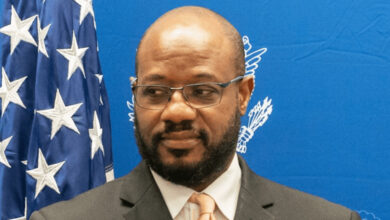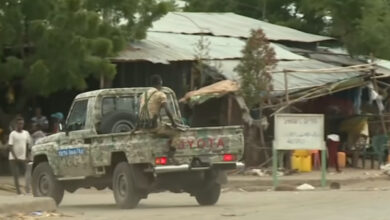In the shadow of the bombs
Two million people call the Las Vegas area home; another forty million tourists from all over the globe visit every year. It is an area sixty-five miles from the most nuclear-bombed place on earth, yet no one worries about it, writes our US Correspondent Tomas Mega, from Nevada
Imagine what it would be like living sixty-five miles from the most nuclear-bombed place on earth. Visualize a place where not one detonation took place, as in Hiroshima in1945, but a place where 1,042 nuclear detonations have occurred. Try to get your brain around the fact that the largest of those 1,042 nuclear detonations had the power of 1.3 million tons of TNT, nearly eighty-seven times the power of the bomb that fell on Hiroshima. Just one.
I’m talking about a place where, between 1951 and 1962, over one hundred atmospheric nuclear detonations took place, sending large atomic clouds in an easterly direction, many hundreds of miles. Another 921 underground detonations occurred in the span of forty-one years between 1951 and 1992.
Surely, nobody with an ounce of sense would live anywhere near such a place. Not a soul would drink the water. No one would farm the land. Who would want to raise children there? And certainly no government would allow it anyway.
Think again. It’s right here in the desert southwest of America; it’s called the Nevada National Security Site (formerly known as the Nevada Test Site) and I live sixty-five miles from it, in Las Vegas.
Two million people call the Las Vegas area home. Another forty million tourists from all over the globe visit every year, enjoying the opulent casinos, mega-sized hotels, cutting edge restaurants and world class entertainment. Don’t like to gamble? No worries. Just about anyone who is someone performs here. Lavish shows, gambling, comedians, culture, cuisine and even sin; yeah, we got that.
The truth is it’s a nice place to live. We have a warm year-round climate, with over 300 days of sunshine each year. The landscapes are breathtaking. Nevada is one of seven states in America without a state income tax to pay, and we have some of the lowest property taxes in the nation. There is the exhilaration of living in one of the most exciting cities in the world. Before the great recession of 2007, this was one of the fastest growing metropolitan areas in America, expanding by over 40%. All in all, there isn’t much to complain about here. Surprising, perhaps, being just down the road from the most nuclear bombed place on the planet.
Still, there are things that worry people. They’re issues that make people think twice about settling here, raising a family, and what kind of future their children may have. But those issues have nothing to do with all the bombs. It’s water, or the lack of it, that troubles us most. The western United States has been in the midst of a decade’s long drought, and water levels on the Colorado River, the lifeline of the desert southwest, continue to fall.
Those 1,042 nuclear detonations seem to matter little. Why is it different here? Why are they not building sumptuous hotels and casinos in Fukushima? Why are there no scantily clad showgirls in Chernobyl? I don’t think Elton John has played Three Mile Island either. The simple answer is we didn’t have any massive nuclear accidents. Those places did.
Las Vegas not only survived, it thrived. In what must be one of the most surreal moments of the ‘Atomic Craze’ that swept Las Vegas in the early 1950’s, the Las Vegas Chamber of Commerce published calendars that listed the days and times of atomic detonations and the best places for the public to view them. Tourists packed ‘atomic box lunches’ and picnicked as close to the blast sites as government restrictions would allow. The Sky Room at the Desert Inn Hotel became a favourite spot for tourists to view the mushroom clouds less than seventy miles away. Economically, the area flourished, not only with atomic tourists but with thousands of jobs and around $176 million of federal money that poured into the area.
Not everything went well, however. In the 1970 Baneberry underground blast, the soil of the ground cracked in an unexpected way and released a plume of radioactive dust which got caught up in the jet stream. And the town of St. George, Utah, 135 miles to the east of here, received the brunt of nuclear testing fallout from atmospheric detonations, with marked increases in the number of cancers occurring there. A 1979 study in the New England Journal of Medicine reported that: “A significant excess of leukemia deaths occurred in children up to 14 years of age living in Utah between 1959 and 1967, and was most pronounced in those residing in counties receiving high fallout.”
In 1954, the movie The Conqueror starring famed Hollywood stars John Wayne and Susan Hayward was filmed around St. George, Utah. The nuclear fallout in St. George is often blamed for the unusually high number of cancer deaths among the cast and crew, including Wayne and Hayward. Wayne’s sons, Patrick and Michael had accompanied their father to St. George. Michael Wayne died from skin cancer, and Patrick Wayne had a breast tumour removed. The eccentric billionaire Howard Hughes produced the film.
Las Vegas continues to be one of the most visited cities in the world. We don’t worry much about what happened in the past. Like most people, we look to the future. But for the many victims who paid the price of living in the shadow of the bombs, a verse from the song “Between the wheels,” written by the Canadian rock band Rush comes to mind:
“You know how that rabbit feels
Going under your speeding wheels.
Bright images flashing by,
Like windshields towards a fly.”
Caption: “Operation Teapot” nuclear test in 1955
Photo: Wikimedia Commons






